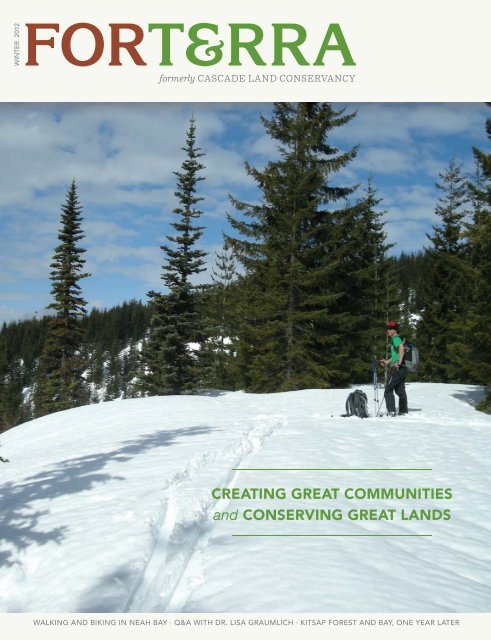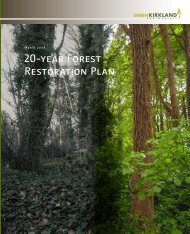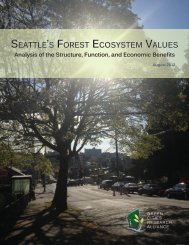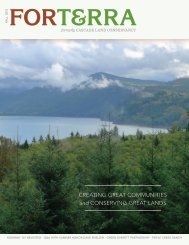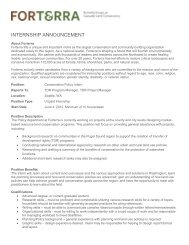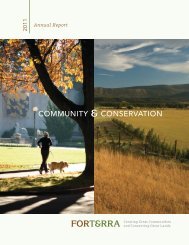Download - Cascade Land Conservancy
Download - Cascade Land Conservancy
Download - Cascade Land Conservancy
- No tags were found...
Create successful ePaper yourself
Turn your PDF publications into a flip-book with our unique Google optimized e-Paper software.
WINTER 2012formerly CASCADE LAND CONSERVANCYCREATING GREAT COMMUNITIESand CONSERVING GREAT LANDSWALKING AND BIKING IN NEAH BAY · Q&A WITH DR. LISA GRAUMLICH · KITSAP FOREST AND BAY, ONE YEAR LATER
For organization-wide questions,please contact our main office inSeattle:901 5th Avenue, Suite 2200Seattle, WA 98164T 206-292-5907For our work in the South Soundarea, please contact our office inTacoma:1119 Pacific Avenue, Suite 1300Tacoma, WA 98402T 253-274-4955For our work in CentralWashington, please contact ouroffice in Ellensburg:409 North Pine StreetEllensburg, WA 98926T 509-962-1654on the cover: Ski touring at Noble Creek. Forterra conserved the 642 acre property in 2008.The purchase was part of the larger I90 Wildlife Corridor project. Learn more about the projecton Page 10 of this issue. Photo by Elsa Sargent. BELOW: Looking across Lake Kachess fromMt. Amabilis, another Wildlife Corridor conservation project. Photo by Jodie Galvan.Please contact the followingindividuals for particular businessneeds at Forterra:EXECUTIVEGene Duvernoy, President,206-905-6900Bonne Tabb, Assistant to thePresident, 206-905-6900Teresa Macaluso, Executive VicePresident & Chief OperatingOfficer, 206-905-6949Michelle Connor, Executive VicePresident, Strategic Enterprises,206-905-6899Ann Gygi, General Counsel,2206-905-6917Table of Contents3 Message from the President4 Our Vision5 Out and About6 Neah Bay’s Walkable, Bikeable Path to a Healthier Community8 Tackling Climate Change at Home: a Q&A with Dr. Lisa Graumlich10 The Road to Conservation12 The Business of Community and Conservation14 Conserving a Uniquely Tacoma Quality of Life16 Great Global Region: Utilizing Green to Make Green17 Kitsap Forest and Bay, One Year Later18 Volunteer Spotlight: John Howell19 Chair’s PerspectiveLake KachessFORTERRA.ORG
message from the president ///////////////////////////////////The <strong>Cascade</strong> and Olympic Agenda map new pathstoward a sustainable region. Fundamentally, it startswith saving our precious lands. But it doesn’t end there.Sustainability also requires great communities whereour families choose to live so we do not sprawl over thecountryside and defeat our work to save landscapes. Itdemands a healthy and globally competitive economyso we do not sell ourselves cheap and squander our landresources just to stay afloat.We are constantly exploring new ways of achieving acomprehensive sustainability. One of the ways is throughour partnership with Davis Wright Tremaine to host Creating A Great Global Region.It is an ongoing conversation with the Forterra community to explore the linkagebetween the strong communities, lands and economies necessary for a sustainableregion. The most recent conversation focused on emerging ecosystem servicemarkets (you can read more about the event on page 15). Our ecosystems provideservices, like cleaning our water or providing salmon habitat that can be valuedeconomically in order to offset the impacts of our growth. The evening discussionnot only will help shape Forterra’s own ecosystem service work, but highlightedsome important themes that resonate across our mission. As we implement ourcritical community building and conservation work we need to:• First, think interconnectedly: we must recognize our communities andlandscapes are intrinsically linked.• Then think broadly: we must think beyond singular projects or issues tobroadly address our most pressing challenges.• And think big: we must bring our efforts to scale and not limit our goalsor expectations of ourselves• Absolutely think creatively: we must examine the options and use ourbest thinking to develop unprecedented approaches• But also think realistically: we must be pragmatic and find solutions thatwork for our landscapes, communities and economy.• And, finally, think deeply about us: we must ensure we shape a future thatwelcomes and accommodates all our current and future residents.In this issue, you’ll see how we’ve been applying these themes to our ecosystemservice development projects and across all our work. Partnering with the MakahTribe to increase opportunities for walking and biking in Neah Bay demonstratesthat these themes are relevant in communities across Washington. Our conservationwork along the I90 corridor and Yakima River Canyon Scenic Byway illustrateshow these themes are important for preserving wild lands. You’ll learn how ourbusiness partners have incorporated these themes and taken great strides instewardship and carbon sequestration. And, you’ll also read about Tacoma transferof development rights, the Kitsap Forest and Bay Project, Tree Ambassadors andan engaging interview on climate change with Dr. Lisa Graumlich, Dean of theUniversity of Washington’s School of the Environment.Sustainability requires a region willing to build on these themes and simultaneouslygrapple with conserving its landscapes, creating great communities and securing itseconomy. And though tension can arise between these goals, it is only by workingtowards all three together that we can succeed with any one. As we move into theNew Year, the themes learned in our Great Global Region conversations will helpus continue exploring emerging trends and opportunities to find solutions neverbefore considered. Together we can make our region outstanding and sustainable.CONSERVATION ANDCOMMUNITY PROGRAMSJill Scheffer, Senior ManagingDirector, Conservation,509-962-1654Liz Johnston, ConservationTransactions Director,206-905-6925Jordan Rash, South SoundConservation Director,253-274-5673POLICYSkip Swenson, Senior ManagingDirector, Policy, 206-905-6935Leda Chahim, Government AffairsDirector, 206-905-6922STEWARDSHIPHayes Swinney, Acting ManagingDirector, 206-905-6950Kory Kramer, Green Cities ProgramManager, 206-905-6923DEVELOPMENT & OUTREACHGiyen Kim, Managing DirectorDevelopment and Marketing,206-905-6930Natalie Cheel, Marketing Director,206-905-6927Jodie Galvan, Major Gifts Officer,206-905-6950Kristen Kosidowski, OutreachProgram Manager, 206-905-6931BUSINESS SERVICESMelissa Laird, Controller,206-905-6918Christopher Walter, GIS Director,206-905-6898Gene Duvernoy, PresidentWINTER 2012
our vision ///////////////////////////////////////////////////////////////OUR MISSION: Forterra’s mission is to act with immediacy to protect, enhance andsteward our region’s most precious resources—its communities and its landscapes.Filling a unique niche as the largest conservation and community building organizationin Washington State, we are working to build the foundations for our sustainableenvironmental and economic futures in the face of arapidly growing population.THE CASCADE AGENDA is a 100 year vision andimmediate action plan for the lands and communitiesof our region. It is based on the input of thousandsof residents across our region and offers pragmaticsolutions to the challenges and opportunities createdby our tremendous population growth. The <strong>Cascade</strong>Agenda’s collective vision is grounded in the belief thata broad coalition can achieve fundamental change. Itis a balanced approach to conservation and communitybuilding that encourages collaboration across all sectorsand considers environmental, social and economic needs.The <strong>Cascade</strong> Agenda brings together business, civic andgovernment leaders to accomplish two big goals:Our <strong>Land</strong>s: Protect 1 million acres of workingforests (93% of existing timberland) and farms(85% of current agricultural lands) and 265,000acres of shorelines, natural areas and parks.Our Communities: Maintain our rural economiesand way of life and enhance the vibrancy andlivability of our cities and towns.4THE OLYMPIC AGENDA is an emergingconversation with the residents of the OlympicPeninsula to shape a future of great communitiesand healthy landscapes. CLC is working withresidents, organizations and businesses of thePeninsula to create a 100-year vision andimmediate action plan for the lands, communitiesand economy of Clallam, Grays Harbor, Jeffersonand Mason Counties. Drawing on the experienceof creating The <strong>Cascade</strong> Agenda, CLC will identifyand help implement strategies that will providea non-regulatory guide to conservation andcommunity growth.FORTERRA.ORG
OUTABOUT//////////////////////////// /////////////////////////////Clockwise from top left: Volunteers from Microsoft lent a hand at Hazel Wolf Wetlands Preserve for United Way’s Day ofCaring. Photo by Alexander SpitsynJordan Rash, Tacoma Mayor Marilyn Strickland, Gene Duvernoy, Helen Engle, Dr. Ernest Bay, and Tacoma CouncilmemberRyan Mello at the South Sound Conservation and Community Event. Photo by Andy GregoryThe Ivy Monster testified at a Seattle City Council in support of Green Seattle Partnership funding. Photo by Skye SchellThanks to an NEA grant, Forterra lead a set of facilitated conversations on redeveloping historic downtown Aberdeen.Photo by Skye SchellJim Huckabay spoke to guests at Canyon River Ranch outside Ellensburg for the Celebrate the Yakima River Canyon ScenicByway event in September. Photo by Kristen KosidowskiVolunteers pitched in along the Duwamish River in Tukwila for the Restore the Duwamish Shoreline Challenge kickoff eventin September. Photo by Kristen Kosidowski5WINTER 2012
NEAH BAY’S WALKABLE, BIKEABLE PATH TO A HEALTHIERCOMMUNITY By Becca Meredith, Community Engagement Project Associate6Driving into Neah Bay, you can feel you’ve entered aspecial place. Oral tradition tells us that the Makahpeople have lived here since the beginning of time. Theyrefer to themselves as “Kwih-dich-chuh-ahtx” or “thepeople who live by the rocks and seagulls.” Historically,the Makah people lived in five villages on over 300,000acres of land. However, upon signing the Treaty ofNeah Bay in 1855—which guaranteed them amongother things, the right to fish, hunt and whale and theprotection of their health, education and welfare—theMakah ceded much of their land to the United States.Forterra is working with the Makah Tribe to help improvecommunity health by making it easier to walk and bikein Neah Bay. The work is one of six community planningassistance projects with cities and tribes around theregion funded through a grant from the EnvironmentalProtection Agency’s (EPA) Office of SustainableCommunities. We are also working with Federal Way,Kirkland, Issaquah and the Quinault Indian Nation tocreate and implement new policies or practices that assistwith development goals and quality of life improvementsor increase economic and environmental sustainability.Alex Pagliere leads a bike repair workshop. Photo by Nick Cillufo
Development in Neah Bay has traditionally beenauto oriented and there are many areas withoutsidewalks or dedicated bike lanes. The communitywants to make walking and biking safer to encouragehealthy, active living. During a visit with the Tribe’sCommunity Transformation Coalition and HealthCenter staff in August, Forterra and members of thecommunity discussed the possibility of a communitybike shop, building local expertise in bike repair andimproving Neah Bay streets for walkers and bikers.In October, we took the next steps with a bike repairworkshop, a freshman focus group to develop aplan for a bike/walk to school day, three walkingaudits to assess the current state of Neah Baystreets with suggestions for future improvementsand a discussion about the feasibility of opening acommunity bike shop.As a small and remote town, Neah Bay presentsunique barriers to residents interested in biking,starting with access to the bikes themselves.Community members often cannot afford newbikes, make it to the Walmart an hour and a halfaway to buy one or fix the bikes in their backyard.A community bike shop could serve as a potentialsolution for all three.Alex Pagliere from the Bikery, a community bike shopin Seattle, joined us in August to help run the bikerepair workshop and share his experience with theshop. He explained that the Bikery is a non-profit thatrelies entirely on volunteers and receives most of itsparts and bikes via donation. From this, communitymembers were able to determine which parts of themodel would and would not work for them as theylook to create their own shop.A community bike shop is, of course, just one partof our effort to help give Neah Bay residents greateropportunities to walk and bike. Over the course oftwo successful days of walking and biking in NeahBay, new skills were gained, ideas were shared, planswere made and new leaders emerged, carrying thisexperience into the future for Neah Bay residents.That, in turn, is just one example of how Forterraengages with communities to advance our commongoals. We are currently working with sevencommunities in addition to Neah Bay to help plansustainable communities, engage residents in theplanning process, create urban agriculture policies,help officials reach out to diverse constituents andmore. Working with cities, towns and communitymembers around the region to help themimplement their visions for creating a better placeto live is at the heart of Forterra’s community work.As we work towards creating great communities inwhich people choose to live, work, shop, play andraise their families, we help conserve our state’s wildand working lands from development pressureand sprawl./////////////////////////////////////////////7Forterra staffers leading a walking audit in Neah Bay. Photo by Skye SchellWINTER 2012
TACKLING CLIMATE CHANGE AT HOME:a Q&A with Dr. Lisa Graumlich By Josh Cohen, Media Associate8Dr. Lisa Graumlich, Dean of the University ofWashington’s College of the Environment, is a leaderin the field of paleoecology and climate change adaptation.In short, she examines long-term natural and historicalclimate records to understand how ecosystems and humansocieties adapt to climate change. She is renowned forher interdisciplinary work exploring climate impact on landand resource management. We sat down in her office todiscuss her early inspiration to study climate change, heracademic focus, tackling the climate change problem inthe Pacific Northwest, potential solutions and more.Your academic focus is on the way ecosystems and humansadapt to climate change. What does your paleoecologyresearch entail? What about it interests you?It goes back to when I was a kid. My grandfather was afarmer and on summer mornings I would walk out into thefields with him to look at the corn. He was a man of fewwords, but I could tell when the weather was cooperatingand the corn was growing as he expected. And I certainlycould tell when the corn was not because, whether therewas drought or flooding, he was watching his livelihoodlose value before his very eyes.That stuck with me. In 1977 there was a drought on theWest coast. It was the most severe drought since the DustBowl. At that point, I was a graduate student studyingtropical ecology. But that drought hit me hard. Climatescholars were puzzled: “Is this just natural variability or is itclimate change?” I immediately thought of my grandfatherand realized the implications of that simple question werehuge. In this way, my work with climate change has its rootsin a deep understanding that if we don’t provide robustscience to people making decisions about managing landand resources, we’re not serving our community. So fromthat time onward I’ve been trying to understand the natureof climate change, climate variability and what it means toreal people. I did that by studying data from tree rings, icecores and other paleodata to demonstrate how currentclimate trends exceed natural variability of the past1000+ years.Nationally the dialogue on climate change is prettylackluster. How can we shift towards a more robustconversation about this pressing issue? How would yousay the subject is being discussed in Washington Statecompared to the national conversation?I agree that we are, at best, stalled in the nationalconversation on climate change. When I moved to thePacific Northwest, I already knew that discussions herewere more progressive.I’ve been working onunderstanding climatechange and its impact onnatural resources for along time. In my positionsin Arizona and Montana,we would often invitemanagers from resourcemanagement agenciesaround the U.S. westernstates to workshops aboutclimate change. I wasalways struck by how theresource managers fromWashington understood climate change in a nuanced,sophisticated way compared to their colleagues. Theyunderstood differences between trends and variability.They understood how to think about risk. I finally cameto realize that this understanding was due in large part tothe work of the Climate Impacts Group (CIG) out of theUniversity of Washington.Over the last 15 years, CIG has been working withstakeholder groups, tribes, state agencies, federalagencies, and anyone who’s interested, to understand howclimate change may or may not affect their lives. They doit by having dialogues with people; understanding whatthey value and what it is they’re trying to achieve, whetherit’s a farmer or the shellfish industry or tribal communitiesconcerned about salmon. The Climate Impacts Group hasbeen able to create a way in which adapting to climatechange, and in some cases trying to mitigate the effects ofclimate change, is woven into the decisions being madein our state. It is a way of partnering and working togetherto understand vulnerability and make a plan that you canactually implement. That’s really, really exciting.Part of why this is so exciting goes back to howproblematic the national dialogue on climate change hasgotten. I think we, as scientists, showed people a lot ofscary pictures of what the world was going to look like in2050 or 2100. We’ve learned that scaring the socks offpeople isn’t an effective way of creating a plan for thefuture. Instead, we can gain traction on this problem usingthe Climate Impact Group’s model of understanding whatpeople value, how people are seeking to create a futureon their land or on a landscape, then working with them tounderstand how climate change and year-to-year variabilityis going to affect them.FORTERRA.ORGPhoto Courtesy the University of Washington, College of the Environment
The <strong>Cascade</strong> and Olympic Agenda’s center on theidea that great communities in which people want tolive, work and raise their families play a critical rolein protecting our wild and working lands from sprawl.What role do you see the built environment playingin positively impacting climate change?The built environment is absolutely key. I’ve beeninspired in this arena by Forterra’s partners, includingDaniel Friedman, Dean of the College of the BuiltEnvironment at UW. Daniel and his colleagues haveeducated me about about how housing density reducesenergy consumption, not only from the housing itselfbut from vehicular traffic as well. And, importantly, howintensifying urbanism works to preserve lands outsideof urban core areas.As a relatively new Seattle resident, one of the strikingthings for me is that Seattle is dense not just in termsof structures and people, but also in terms of ideas andcreativity. We know urban centers are idea generators.One of my favorite examples is the Beacon FoodForest that is about to be launched in the Beacon Hillneighborhood. It will be the nation’s largest food forest,with perennial trees and bushes alongside annual cropscreating a great, diverse mix of foodstuffs. And it wasan idea that came out of a permaculture workshop;Seattle residents came together to share knowledge,came up with a bold new idea and made it happen.The built environment has an impact on climate changein obvious ways that we already understand. But Ithink there will also be wonderful surprises that comefrom continuing to have sustainable, healthy urbanismfront and center in our aspirations. Healthy for people,healthy for our biodiversity, sustainable in terms ofenergy and materials and something that actually workseconomically and socially. If you can bring that alltogether, you will achieve some of the long-term goalsForterra and friends of Forterra have.At the Great Global Region speaking event, yousaid that ecosystem service markets provide anopportunity to take us from aspirational ideas topragmatic solutions. What sort of market-basedsolutions can best impact the environment? How arethose ecosystem service markets helping in the PugetSound Region?This is a great topic, timely and, at this point, openended.Here at the UW, we have major researchprojects on ecosystem services that that are seekingnew ways of understanding the valuation of the manyservices we derive from ecosystems. We also havecolleagues at the Natural Capital Project that aredoing a deep dive into how you actually value multipleecosystem services in landscapes around the world.The science is moving quickly, and we are increasinglyable to articulate tradeoffs. However, there is still afair amount of uncertainty at this point about thosetradeoffs and how they map onto people’s valuesand preferences.That said, while ecosystem services is a new phrase inour vocabulary, we’ve been managing resources withthis in mind for a long, long time. One example I thinkof is how the Soil Conservation Service was born outof the Dust Bowl. Using the best available science, andworking closely with farmers, agricultural scientistsdevised ways to manage land for both environmentaland socioeconomic benefits over the long haul, not justextracting maximum productivity for a given year.In this vein, my goal is that UW will continue to workwith Forterra and its community partners to ensure thatthe kinds of science that we pursue leads to conceptsand tools for making the very difficult decisions that lieahead. In academic circles, we often say we are workingto create solutions. I think back to my grandfather’sfarm when I argue that a solution is only a solution ifpeople are able to use it to make hard decisions andtake concrete actions.It’s clear we have a significant problem on our hands,but it’s also clear that you see aspirational solutionstowards which we can work. To wrap things up,where do we go from here?As I mentioned, solutions are only solutions if peopleuse them. I see examples like Climate Impacts Groupand the work being done on ecosystem services asexcellent examples of the importance of engagementbetween the scientific community and entities likeForterra. We can bring the scientific understandingof our history to bear on how we move toward ourfuture. And, the incredible opportunity here in thePacific Northwest is that we truly are following themantra of thinking globally and acting locally. And inusing science to do that and having deep communityengagement, we are building a sustainable region.9WINTER 2012
10THE ROAD TOCONSERVATIONBy Diedra Petrina, KittitasCounty Project Coordinator &Josh Cohen, Media AssociateInterstate 90 is one of Washington State’s mostcritical pieces of infrastructure. Spanning fromSeattle to the Idaho border, it ferries goods acrossthe state, brings tourists and their economy-boostingspending habits to the state’s many beautifuldestinations, brings food from Central and EasternWashington’s phenomenal farms to markets west ofthe mountains and so much more. I90 also connectstwo major conservation initiatives Forterra and itspartners are engaged in: the I90 Wildlife Bridges andthe Yakima River Canyon Scenic Byway projects.I90 Wildlife BridgesThe I90 Wildlife Bridges project centers on a 15-mile stretch of the interstate between Hyak andEaston being expanded by the Washington StateDepartment of Transportation (WSDOT). Every day,an average of 27,000 cars and semi-trucks crossSnoqualmie Pass, causing frequent traffic jams andfurther impacting the deteriorating road quality.The expansion will help reduce traffic problems andimprove road conditions, freight mobility, safety andecological connectivity. As part of the expansion,WSDOT is building wildlife bridges over and underthe highway at strategic points to allow animals tosafely cross.In order to increase the effectiveness of the bridges(thereby increasing safety for animals and drivers alike),a partnership formed to conserve land around thefuture bridge sites. The partnership includes the I90Wildlife Bridges Coalition, Forterra, the U.S. ForestService, Washington Fish and Wildlife and the SierraClub. In addition, organizations such as Mountains toSound Greenway and Trust for Public <strong>Land</strong>s have beenimportant partners in the corridor effort.In the past five years, Forterra has conserved over3,000 acres of wildlife habitat along this corridorto support the wildlife bridges project. The land isstrategically targeted for its good habitat locatedin areas that compliment other public lands andwildlife corridors. Most recently, we conservedFORTERRA.ORGLookingLookingdowndowntotoI90I90fromfromKeechelusKeechelusRidge.Ridge.PhotoPhotobybyCharlieCharlieRainesRaines
a 480-acre property at Mt. Amabilis near Eastonusing grant funding from the U.S. Fish and WildlifeService. Forterra owns the land and the WashingtonDepartment of Natural Resources holds a conservationeasement on the property, ensuring the land will bepermanently protected. Forterra will steward theland to maintain and enhance wildlife habitat valuesto support deer, elk, cougar, bear, bobcat and otherspecies that use it.Looking forward, we are working to conserve around2,000 more acres of habitat in the wildlife corridor,some as soon as this winter.Yakima River Canyon Scenic BywayContinuing east on I90 as it passes Ellensburg,you come across State Route 821, known bymany as Canyon Road or the Yakima River CanyonScenic Byway. It is one of the prettiest drives you’llexperience in Washington. It winds along the YakimaRiver through hills of basalt rock and wildflowers ofthe shrub-steppe. If you are lucky you’ll see baldeagles perched on a ponderosa pine, big horn sheepnavigating the cliffs and, in the spring, pelicansplaying in the river. It is also Washington State’svery first scenic byway, officially declared as such byGovernor Dan Evans in 1968.In 2010, Forterra began to lead an effort tohighlight and prioritize the importance of the Bywayand formed a partnership of nearly 30 differentorganizations and landowners. This powerful groupis working to conserve nearly 14,000 acres of landalong the Byway, update the Corridor ManagementPlan, build an Interpretive Center at the North end ofthe Canyon and secure safe river access and wildlifeviewing sites.In just two short years the partnership has severalimportant accomplishments to its credit. In 2010,Forterra secured $1.625 million to purchase 700 acresof endangered shrub-steppe habitat. In 2012, theWashington Department of Fish and Wildlife (WDFW)ranked the project third for state funding for a $1.5million grant for additional habitat purchases. TheKittitas Environmental Education Network (KEEN) andForterra are updating the Corridor Management Planworking closely with WSDOT. The plan is a blueprintfor the Byway that was never implemented. Updateswill be completed this winter.Most recently, KEEN received an $800,000 grantto build an interpretive center at the north end ofthe Canyon. The center will help improve the park’svisibility and could serve as the focal point in theeffort to capitalize on the canyon as a tourism andenvironmental attraction. Over the next few monthsthe partnership will work on raising additional funds tocomplete the Interpretive Center, finalize the WSDOTportion of the Corridor Management Plan and holdcommunity-building events in the Canyon.Forterra is looking for additional partners to assistwith planning in the Canyon especially in outdoorrecreation fields like cycling, fishing, hunting andhiking. Please contact Jill Scheffer in our Ellensburgoffice for more information and to join in thisimportant work.Further Down the RoadAs we move into 2013, we will continue to worktowards conserving great lands along the I90corridor and the Yakima River Canyon Scenic Byway.In addition, we are beginning to develop plans forconserving lands along another important Washingtonhighway, Highway 2. The Skykomish Valley has greatwildlife habitat, recreational potential, wildernesslands near Stevens pass and some old growth forest.Conserving land along the Highway 2 corridor, aswe are with I90 and the Canyon, will be critical forretaining those qualities that help make our regionso very special.11WINTER 2012
the business ofCOMMUNITY AND CONSERVATIONBy Josh Cohen, Media Associate12Broad partnerships have always played a central rolein the way Forterra conducts its work. When we saythat we encourage collaboration across all sectors it isnot simply lip service to partnerships. Our critical missionis accomplished by working with fellow nonprofits,grassroots advocates, tribes, government agencies,elected officials and businesses large and small. 2012presented two new and particularly exciting opportunitiesto work with businesses and corporations interested inleading their peers in an effort to conserve great landsand create great communities. The Duwamish ShorelineChallenge and the Carbon Capturing Companies (C3)program demonstrate the way Washington businessesare not only recognizing the importance of our region’senvironmental and economic health but taking aninitiative to protect them. Forterra is excited to have theopportunity to play a leading role.Duwamish Shoreline Restoration ChallengeLaunched in September, the Duwamish ShorelineRestoration Challenge is a unique, business-led effort torestore the Duwamish River in Tukwila. BECU is workingwith Forterra and the City of Tukwila to encourage thebusiness community to support the restoration of theDuwamish with volunteer work and financial backing.The Challenge was inspired by BECU employees who’dfound deep satisfaction giving back to their communitythrough volunteer restoration work along the Duwamish.BECU recognized the significance of their employees’enthusiasm for restoration work. They approachedForterra and the City to build upon that foundationof community stewardship and get the Challenge offthe ground.When all is said and done, the Challenge will restore150,000 square feet of riverbank along 1.5 miles of theDuwamish River. Much of the Duwamish River’s shorelineis overgrown with invasive plants such as Himalayanblackberry that have choked out native vegetation. Theseinvasive species are destroying vital habitat for salmonand other native wildlife and make it more difficult forTukwila’s workers and residents to enjoy the river. Thework accomplished through the Challenge will help makethe Duwamish that much more valuable for wildlife andthe Tukwila community alike.BECU committed $10,000 to the Challenge and isproviding staff time to assist other businesses withhands-on restoration projects. Drawing on our yearsof expertise, Forterra is designing and guiding theshoreline restoration. The City of Tukwila is providingFORTERRA.ORGRepresentatives from the C 3Founding partners on stage at the Conservation Awards Breakfast. Photo by Laura Marchbanks
staff resources and funding for invasiveplant removal, new plantings and ongoingmaintenance.The Challenge officially got underway onSeptember 14th with a restoration event atBECU’s campus along the Duwamish. A greatgroup of employees and other volunteersjoined Forterra, BECU and the City to removeblackberry and lay down sheet mulch.Looking forward, there will be regularvolunteer events to further the restorationgoals of the Challenge. In addition, theChallenge partners will continue to reachout to and encourage the Tukwila businesscommunity to give back by joining the effortto restore their river.Carbon Capturing CompaniesLike the Duwamish Shoreline Challenge,the C3 program is a terrific example of thebusiness community not only recognizing theirreplaceable value of our region’s environment,but leading an effort to protect and enhanceit. Kicked off at this year’s ConservationAwards Breakfast, C3 gives Washington-basedcompanies the opportunity to mitigate theircarbon footprint by providing funding to plantnative trees. Forterra will purchase nativeconifer trees and distribute them to trustedpartners who plant them in protected publicspaces and care for them as they grow. Thesetrees will sequester thousands of tons of CO 2over their lifetime.Once a participant joins C3, they calculatethe carbon emissions for all or part of theirbusiness operations, look for ways to reducetheir footprint and then provide funding toplant native conifer trees to mitigate theirremaining impact. Forterra and a team ofadvisors will select which projects have theappropriate merits for ensuring the trees areplanted properly and cared for over the longrun. Businesses who want to take an even morehands-on approach to the process will have theopportunity to have their employees take partin the tree plantings themselves.The program was launched with 14 foundingpartners including Pearl Jam, the SeattleSounders FC, the Seattle Seahawks, theSeattle Mariners, Outdoor Research, MollyMoon’s Ice Cream, Woodland Park Zoo, CherryStreet Coffee, Glassybaby, Stream Real Estate,GLY Construction, CleanScapes, the SeattleAquarium, and Forterra. Since the launch,Bear Mountain Capital, Mnerva Labs, Keeny’sOffice Supplies and NuBe Green joined as2012 participants.Pearl Jam guitarist Stone Gossard was a majordriving force in the creation of C3. He and theband worked with Forterra previously to offsetthe carbon impact of their 2009 world tourin a similar manner. Building on his positiveexperience and desire to make a valuableimpact on his region Gossard proposed thatForterra offer other businesses the sameopportunity to do right by the environmentand themselves.“Pearl Jam recognizes that reducing yourenvironmental impact is an important businesschoice,” said Gossard. “We hope that otherbusinesses are inspired to join us in offsettingtheir impact through C3. Until the businesscommunity and consumers step up, the issueof climate will be kicked down the road tofuture generations.”2012 C3 participants purchased more than5,000 trees to capture over 25,000 tons ofcarbon. Looking forward, we expect even moreenvironmentally-conscious businesses to join C3,expanding the program’s impact and makingour region’s environment that much stronger.When we talk about how special this regionis, we often focus on our amazing wild lands(and with the <strong>Cascade</strong>s and Olympics andPuget Sound and so much more, who canblame us?). But, programs like the DuwamishShoreline Challenge and Carbon CapturingCompanies are a perfect example of anotherway this region is truly unique. We havemajor businesses and corporations not onlyinterested in making a tangible impact ontheir local environment, but taking the lead indoing so. That is special and one of the reasonsbroad partnerships have always been a criticalelement in Forterra’s mission and success.13WINTER 2012
CONSERVING A UNIQUELY TACOMAquality of life with transfer of developmental rightsBy Ian Morrison, Forterra Pierce County Trustee14In 1873, the Northern Pacific Railroad announced thatTacoma’s Commencement Bay would be the terminus oftheir transcontinental line instead of Seattle. Tacoma wassoon declared the “City of Destiny,” due in part to its senseof boundless opportunity and abundant natural resources.Since then, Tacoma has continually fused its ecology,geography and economy to define a vibrant, eclecticcommunity. There is a unique sense of place clearlyreflected in the city’s energetic neighborhoods.Today in Tacoma’s mixed-use neighborhoods like Proctorand South Tacoma, people are experiencing how walkableurban communities can better connect residents with thenatural environment. Families can find great deals on localPuyallup Valley produce at one of Tacoma’s neighborhoodfarmers markets. Tacoma’s waterfront promenade connectsour industrial heritage with Point Defiance Park’s untouchedshorelines. It often comes alive with runners, children andneighbors seeking to be recharged by the Puget Sound.Tacoma constantly reveals new ways to connect with thenatural environment that defines what it means to live inthe Pacific Northwest.As a proud Tacoma native, I believe our civic mission isto ensure these qualities endure for the next generation.Working in partnership with Forterra, Tacoma recently madesteps to further protect the elements that make our regiongreat with the creation of a Transfer of Development Rights(TDR) program that will help conserve private farms, forests,habitat and landmarks sites.This September, the Tacoma City Council voted unanimouslyto adopt a TDR program. The effort was led by MayorMarilyn Strickland and Councilmembers Ryan Mello, JakeFey, David Boe and Lauren Walker, all of whom playedcritical leadership roles in this success. Tacoma is the firstPierce County city to implement a TDR program. In doingso, the City took an important step to foster the sense ofFORTERRA.ORGinterconnection between the daily urban experience andthe Puget Sound natural environment.Tacoma’s TDR program is an innovative, market-based policythat allows for increased targeted urban development withinthe City’s 16 mixed-use centers by conserving importantprivate farm and timber lands, in-city habitat corridors ordesignated Tacoma landmark sites.Tacoma will work with individual landowners, who willsell the rights to build on their farm or timber landsthrough voluntary transactions. A conservation easementprotects these TDR “sending sites” in perpetuity fromfuture development. In exchange, Tacoma will facilitatea market for developers to purchase TDRs. Those TDRsallow development of additional retail and office space orresidential units within the mixed-use centers where boththe infrastructure and community support smarter growth.Perhaps most important is the promotion of regionalconservation goals. The natural wonders that define thePuget Sound do not stop at county borders. Tacoma’s TDRprogram is not limited solely to sending sites within thecity. Instead, it is part of a broad regional TDR marketplacethat includes Pierce, Snohomish and King Counties. Doingso recognizes the Puget Sound region’s interconnectivity;this spirit of regionalism inspires me. Preserving threatenedPuyallup Valley farm land or eastern Snohomish Countyforest land both greatly contribute to our quality of life. I amproud that Tacoma recognizes that successful Puget Soundconservation does not have to be a zero sum game.With this new TDR policy in place, Tacoma continues itstradition of supporting the vibrant balance of ecology,geography and economy. The TDR program can be animportant tool to foster conservation of critical lands forfuture generations while supporting smart, livable growthwithin our neighborhoods.I am confident we will see the benefits from the regionalTDR market that Forterra is working to establish. With thisPuget Sound network of cooperating cities, counties anddevelopers, we will soon see how TDRs can help conserveworking farms in Sumner while allowing greater densityin Tacoma’s mixed-use neighborhoods to ensure futuregenerations have the same opportunities to experience thelands that defines our region. Achieving this will truly unitethe City of Destiny’s history with its tomorrow.A Tacoma native, Ian Morrison is a Forterra PierceCounty Trustee and former City of Tacoma PlanningCommissioner. He is an associate at McCullough HillLeary, a Seattle land use and real estate law firm.City scape of Tacoma. Photo by Erica Simek.
creating a greatGLOBAL REGIONBy Natalie Cheel, Marketing DirectorOn October 2nd, Forterra and Davis WrightTremaine hosted the second of our GreatGlobal Region speaker series events. The series waslaunched to spur dialog on ways to use communitybuilding and conservation to create a successful,globally-competitive region for the 21st Century. Thesecond event, titled “Utilizing Green to Make Green,”brought together a panel of ecosystem market expertsrepresenting perspectives from business, nonprofitorganizations, and academia. What followed wasan interesting and engaging evening focused onecosystem market opportunities and challenges for thePacific Northwest.Don Tuttle, Founder of Jadora, covered hisinternational experience and how it can be appliedhere, stating that he sees watersheds as an essentialelement to any new markets being created inthis region.TJ Dicaprio, Sr. Director of Carbon and Energyfor Microsoft, gave an overview of their carbonneutrality program and concluded that she sees ahuge opportunity for partnerships with nonprofits,corporations and ecosystem markets.Bert Gregory, Chairman and CEO of Mithun,explained the <strong>Land</strong>scape Conservation and LocalInfrastructure Program and concluded that thisunprecedented approach is a great example ofhow we can utilize the marketplace to improve ourcommunities and environment.Lisa Graumlich, UW Dean of the College of theEnvironment, summed up the panel presentations withfour common threads.1. We need to improve the quantifiable metricsfor how companies and individuals makedecisions about engaging in ecosystemmarkets.2. We need to create accountability andtransparency for providers and consumers.3. We need to help mitigate the risks throughunderstanding and meeting regulatoryrequirements.4. There is an enormous opportunity in apotential trillion dollar market but beyondthat, ecosystem markets can help improve ourcommunities as well as conserve nature. Theyare an opportunity to move from aspirationalideas to implementation of solutions.The dialogue highlighted some critical componentsof a successful ecosystem marketplace and will informhow Forterra shapes our current and future programs.We will ensure that metrics in our C3 program arequantifiable and accessible to businesses for easyparticipation. We will ensure that the ecosystembenefits of our TDR efforts are transparent and wewill continue to understand regulatory requirements tomitigate risks and demonstrate the potential of theseemerging markets.15Photo by Natalie CheelWINTER 2012
Kitsap Forest and Bay, One Year Later ///////////////By Liz Johnston, Conservation Transactions Director16The Kitsap Forest and Bay Project is a landscapeleveleffort to conserve 6,700 acres of forest landand 1.8 miles of shoreline surrounding Port GambleBay in north Kitsap County – a spectacular region ofwestern Puget Sound.This conservation effort is a once in a lifetimeopportunity to help sustain our region’s quality oflife, environmental health and economic vitality.Port Gamble Bay is part of an important ecologicalsystem that supports wildlife species in Hood Canaland Central Puget Sound. The lands and waters ofPort Gamble Bay are also fundamentally importantcultural, spiritual and subsistence resources for thePort Gamble S’Klallam and Suquamish Tribes. Aproposed system of land and water trails will helpbolster tourism and provide recreation opportunities.Conservation of these forestlands will curb the costsfor infrastructure and services that would be requiredif the area were developed.In September of 2011, Forterra and landownerPope Resources entered into an 18-month optionagreement allowing Forterra and its partners untilMarch 2013 to raise the funds necessary to purchasethe forestland and shoreline. Since entering thatoption agreement a little over a year ago, greatprogress has been made towards the end goal ofconserving this transformational landscape.Forterra and its partners have secured or are in theprocess of securing funding from a wide variety ofsources. The conservation funding includes:• $7 million from the Washington StateAppropriation toward the purchase ofPort Gamble Bay Shoreline. Distribution ispending approval of a cleanup agreementfrom the former lumber mill at PortGamble.• A U.S. Navy Mitigation Agreement withthree S’Klallam bands for approximately$3.5 million toward land purchases.• A $400,000 grant awarded to KitsapCounty by the U.S. Forest ServiceCommunity Forest and Open SpaceProgram for the purchase of the 366-acreHeritage Park Addition Block.• We applied for grants through WashingtonState Recreation and ConservationOffice including the Washington WildlifeRecreation Program and Aquatic <strong>Land</strong>sEnhancement Account, National CoastalWetlands Program. Pending approval, thiscould provide up to $3 million for PortGamble Shoreline, $1 million for Divide/Grover’s Creek, and $800,000 for theNorth Kitsap Heritage Park.• In addition to grant funding, the statelegislature extended the compensatingforest tax exemption to includeconservation projects in Kitsap Countywhich will provide significant projectsavings.Kitsap County is also one of ten awardees for theCommunity Forest Program, a new nationwideprogram. Authorized by the 2008 Farm Bill, theprogram protects forests that are important forpeople and the places they call home. The successof the application is undoubtedly due to theproject’s broad community coalition, the willingnessof the forest company to work with the communityand the engagement of the tribes all workingto achieve a long-term objective to enrich thecommunity.The Kitsap Forest and Bay Project has the potentialto help shape the future of the Kitsap Peninsula.Without the contributions of Tribes, governmentagencies, nonprofits, community leaders and others,a project of this magnitude simply could not becompleted. With the option agreement nearingits deadline, Forterra and our partners are hard atwork. Help us by contacting your legislators andasking them to fully fund the Washington WildlifeRecreation Program (WWRP). While WWRP won’tconserve all of the land, it could secure keystones.You Can HelpFor information on whom to contact in thelegislature and how best to advocate for WWRPfunding, please contact Leda Chahim, ForterraGovernment Affairs Director at (206) 905-6922.FORTERRA.ORG
IN OUR BACKYARD: Seattle tree ambassadorsBy Andrea Mojzak, Green Cities Project CoordinatorThe Tree Ambassadors are a community of urbanforestry volunteers educating their neighbors aboutthe importance of Seattle’s trees and how to keep themhealthy. Launched in 2011, the Tree Ambassadors programwas created as an on-the-ground resource available toanswer Seattle residents’ most frequent questions abouttheir neighborhood trees. The program is part of SeattlereLeaf and is supported by Forterra, Seattle Department ofTransportation and Seattle Public Utilities.To prepare for their role, Tree Ambassadors participatein a nine-part training series that equips them with theknowledge necessary to serve as resources for theircommunity. They learn the answers to many commonquestions such as: Who is responsible for taking care of thetrees in the parking strip? (If SDOT planted them, SDOTis responsible. If they didn’t it is the responsibility of thehome/property owner.) Can I cut down the tree in myneighbor’s yard if I think it unsafe? (No, you can only cutdown trees on your own property that meet the current DPDtree regulations.) Why does City Light come through andcut my tree without my permission? (City Light maintains a10ft clearance around live power lines.)The City of Seattle has a goal of reaching 30 percent treecanopy cover by 2037 and much of the potential plantingPhoto by Sandra Pinto deBaderarea falls in private, single family residence lots. TheTree Ambassador program is a great vehicle to inspirehomeowners to plant trees in their own yards througheducation and outreach. The Ambassadors do outreach atschool events, neighborhood festivals and farmer’s markets.They highlight trees in their own neighborhoods withguided and self-guided tree walks.The program isn’t just about creating more tree huggersin the city—Seattle’s urban forest provides significantand quantifiable value to the city. The recently publishedSeattle’s Forest Ecosystem Values: Analysis of the Structure,Function, and Economic Values found that Seattle’s treesand tree-like shrubs provide the city $23 million in savingsannually through carbon sequestration, storm waterabsorption, heating and cooling and pollution reduction.With only two years under its belt, the program is justgetting started. Looking forward, the goal is to have a TreeAmbassador in every neighborhood in Seattle ready tochampion the health of our urban forests. With that willcome more tree walks, more outreach and new and excitingways to increase and improve Seattle’s amazing tree canopy.Want to take a tree walk around a Seattleneighborhood? You can find one here:http://seattle.gov/trees/treewalks.htm17WINTER 2012
Board of DirectorsOFFICERSPeter Orser, ChairWeyerhaeuser Real Estate CompanyJim Greenfield, Vice ChairDavis Wright TremaineBruce Williams, Treasurer and Immediate Past ChairHomeStreet BankPatti Case, SecretaryGreen Diamond Resource CompanyMEMBERS AT-LARGERob Bernard , Microsoft CorporationJJ Collins, Freestone Real Estate LLCGene Duvernoy , PresidentNicole Faghin, Washington Sea GrantDaniel Friedman , UW, Dean, College of Built EnvironmentsBert Gregory, AIA, Mithun Architects, Designers, PlannersA-P Hurd , Touchstone CorporationTerry Mutter , The Boeing CompanyKen Myer , Vantage PointGreg Nickels , Former Seattle MayorDan Nordstrom, Outdoor ResearchThomas O’Keefe, River AdvocateFrank Pritchard, Emeritus Board MemberNatalie Quick, Natalie Quick ConsultingFloyd Rogers, Open Space AdvocateJoe Sambataro, Labor Ready Inc., RetiredBroderick Smith, Urban VisioMarilyn Strickland, Mayor, City of TacomaBill Taylor, Taylor ShellfishAaron Toso , Gallatin Public AffairsDave Towne , Towne Planning ServicesRuth True, NuBe GreenDoug Walker, WRQ, Founding PartnerAndy Wappler, Puget Sound EnergyRon Whitener, UW School of LawTrusteesKING COUNTYThomas O’Keefe, ChairBrooke AlfordMark BoyarCrystal CarterWally CostelloNona GanzCarolyn HopeCraig KruegerDoug McClellandHarry MorganDave RussellChuck WolfeJanet WallKITTITAS COUNTYJim ArmstrongJim BriggsDeborah EssmanKirk HolmesJim HuckabayJeff JonesKelly LarimerJason SmithTami WaltonMASON COUNTYPatti Case, ChairJean FarmerBob HagerTom HamiltonTerri JeffreysFORTERRA.ORGBrian McGinnisDan O’NealDavid OvertonDawn PannellBob SimmonsBill TaylorPIERCE COUNTYAaron Toso, ChairBruce BeckettKatrina BloemsmaIone ClagettTom GaldabiniKris KauffmanIan MorrisonNancy PearsonMonty SmithHerb StumpfDerek YoungAllen ZulaufSNOHOMISH COUNTYNicole Faghin, ChairJay GoodwinStephanie HansenLinda NeunzigAllison RaduzinerScott SchrefflerDJ Wilsonvolunteer spotlightJohn Howell: Guiding Forterra toGreatnessBy Natalie Cheel, Marketing DirectorForterra’s success over the past23 years would not have beenpossible without the support ofdedicated community leadersdonating their time, energy andwisdom to our mission. John Howellserved on our Board of Directorsfor 20 years and was instrumental inshaping Forterra into the organizationit is today. He served as Board Chairfrom 2005 to 2007, playing a criticalrole in the creation and launch of the <strong>Cascade</strong> Agenda. Hisleadership and thoughtfulness helped take the Agenda froman unprecedented and bold idea to the solid roadmap for theregion being implemented today.John possesses a great ability to encourage the engagementof people from widely different perspectives and alwayscontributed a fresh voice at the table. His demeanor and poiseinvited participation and his remarks at our events were nevershort of inspirational.Recently, John decided it was time to retire from theBoard. His resignation letter exemplifies his generous andcollegial demeanor.I want to thank you and the entire organization forproviding me with such a satisfying experience duringthe past 20 years. As a board member I have madegood friends, watched with pride at the incrediblegrowth of the organization, and most importantly, feltthat we have truly made a difference to protect thequalities of this region that make it so special.I am most proud of the work we all accomplished onthe <strong>Cascade</strong> Agenda. We have given a gift to ourfellow citizens by creating a 100 year vision that willserve as a blueprint for the region we want to become.The Agenda’s power lies in its audacious time horizonand its common sense approach to accepting growthin the “right places” and protecting the naturalfeatures of our region that we cherish. With thepassage of time, as Forterra continues to be a stewardof this plan (just as we care for and nourish the landsthat we own) the Agenda will take on a certain wisdomand power for the generations that follow—just at theOlmsted Plan did for our generation.John’s wisdom and grace built an incredible foundation atForterra. Working with John is a career highlight for employeesand his board colleagues. We are truly grateful for all of hiscontributions. Thank you John!
chair’s perspectiveBy Peter Orser, Chair of the Board of DirectorsTwo years at the helm ofForterra’s Board of Directorshas afforded me a lot of insightinto this organization. I’ve seen theimplementation of the ambitious<strong>Cascade</strong> Agenda and the formativestages of its counter-part TheOlympic Agenda. I’ve seen anorganization continue to grow, thriveand innovate in one our nation’sworst economies. I’ve seen a greatgroup of dedicated employees succeed time and again in ourchallenging and critical mission to build great communities andconserve great lands. In short, Forterra walks the talk and it’sbeen an honor contributing as the Board leader.The content of this issue is further evidence of Forterra’scontinued success with its expanding and maturing mission.The Communities Team is literally helping the health of NeahBay residents with their work improving the town’s walk- andbike-ability. Forterra’s conservation work along I90 and theYakima River Canyon Scenic Byway greatly benefits wildlife,human beings, our lands and our economies in a myriad of ways.Our partnerships with the private sector through programssuch as the Duwamish Shoreline Challenge and CarbonCapturing Companies are advancing our mission in ways otherorganizations cannot.I have always been a fan of Forterra’s mission and its terrificbalance between good economy and good stewardship. In myterm as chair, I got a deeper look into the engine that makesthis mission go—the people. When I pull the dipstick out, it isclear the engine is well oiled with the passion of every associate.In my travels through both nonprofit and for profit enterprises,it has become clear to me that an audacious vision with a clearpath to success excites people much more than fame andfortune. Forterra has shown that over the years and, as a result,attracted some of the region’s best and brightest. I have learneda great deal from them—proving the old adage true—when youengage in your community, you always get more than you give.It has been a pleasure to serve and I look forward to continuingin any way I can.COUNCIL OF ADVISORSGerry Johnson, Chair - Pacifica Law GroupKen Alhadeff - Eltteas EnterprisesPhil Barrett - Private InvestorBob Drewel - Puget Sound Regional CouncilBruce Hosford - Hosford VenturesMike Garvey - SaltchukJohn Howell - Cedar River GroupNick Hanauer - Second Avenue PartnersCarol James - Open Space AdvocateJudd Kirk - Port Blakely CommunitiesBrian Janssen - Onyx FounderMartha Kongsgaard - Kongsgaard Goldman FoundationJohn McCoy - Tulalip TribesDenny Miller - Denny Miller Associates Inc.Dan Nordstrom - Outdoor ResearchBill Pope - Mazama Country InnRon Sher - Terranomics DevelopmentHerb Simon - Simon Johnson LLCDavid Skinner - ShadowCatcher EntertainmentGreg Smith - Urban VisonsCraig UelandMaryann Tagney JonesBob Wallace - Wallace PropertiesFORTERRA ENTERPRISESSteve Ohlenkamp, President - The Communications GroupRod Brown - Cascadia Law Group PLLCJim Greenfield - Davis Wright TremaineJim Reinhardsen - Heartland LLCGary Young - Polygon Northwest CompanyPeter Orser
formerly CASCADE LAND CONSERVANCY901 Fifth Ave, Suite 2200Seattle, WA 98164Non profit OrgU.S. PostagePAIDPermit No. 106Blaine, WAADDRESS SERVICE REQUESTED20/////////////////////////////////////////////////////////////////////////////////////////FORTERRA.ORG


